Osteopathy is a form of physical therapy with a holistic approach that mainly deals with structural aches and pains.
Osteopathic treatment does not target the symptoms but looks at the whole body and tries to resolve the cause of the problem by attempting to restore your body’s structural balance.
Osteopaths believe that by improving the structural balance of the body, the body will function better and therefore be healthier. We create the perfect conditions for your body to encourage the healing process needed to overcome the problem.
To achieve this we use several techniques such as massage, joint articulation, joint manipulation, visceral, cranial, and more.
All the above can be compared to a car and how it functions. A brand new car will run fine but with time and use, you will have wear and tear and you will need to replace or repair some bits.
The same applies to your body and our aim is to keep you mobile as long and as comfortable as possible. If the car is involved in an accident for example, the car will need some more work to overcome the problem.
Again the same applies to your body. Like cars, bodies benefit from an MOT which boosts or maintains your well being before a problem arises. This is called maintenance or preventative treatment.
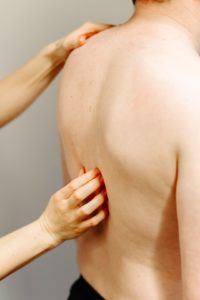
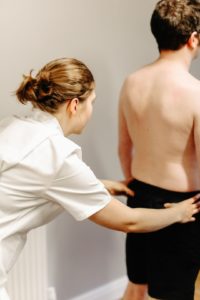
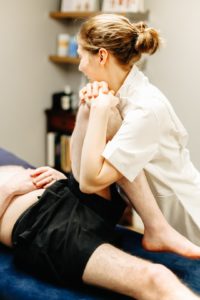
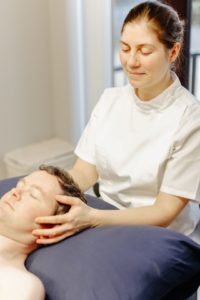
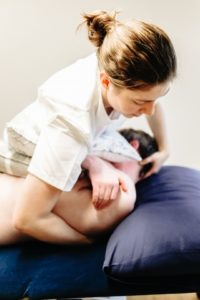
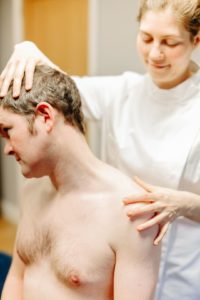
To qualify, an osteopath must study for four years to achieve an undergraduate degree. The degree consists of anatomy, musculoskeletal medicine, pathology and includes more than 1000 hours of training in Osteopathic technique and private practice.
Osteopaths must register with the General Osteopathic Council (GosC). This is our governing body that regulates us. All the osteopaths working at Just Osteopathy are fully registered with the GosC and the British Osteopathic Association.
The most common conditions we treat are:
Patients have found osteopathy helpful for many other conditions and if you would like to discuss if the treatment can be of any benefit to you please contact us.
We also treat babies and their discomforts.
Consent form
Prior to your first treatment you will be asked to read and sign a consent form. This is to confirm that you have understood the procedures of osteopathic treatment.
First appointment
During the first appointment, the osteopath will ask you several questions about your problem. Often osteopaths need to know a lot about your past medical history to get a better understanding of the problem. Some of these questions may seem irrelevant but they are important.
When the questioning is finished, the osteopath will ask you to undress down to your underwear. This is only if the patient is fully comfortable with this. Otherwise you can bring loose fitting clothes instead.
The osteopath will perform a thorough examination by letting you perform some tests and palpating muscles and joints. The osteopath will discuss the findings with you and will explain how to proceed with the treatment.
The osteopath will try to be as gentle as possible and will explain the technique before asking consent. If there are some techniques that you disagree with we will not insist on performing them on you. We tailor the treatment to your needs.
After the treatment, the osteopath will give you some advice on stretches, exercises, and other things that may help you at home.






Consecutive treatments
Several treatments are often needed to resolve a problem however we can’t predict how many treatments are needed to resolve a problem as that depends on many factors.
If it is a severe problem, we often advise to visit at weekly intervals until the pain is at a comfortable level and then we spread the treatments.
When the problem is resolved, we may advise you to come for maintenance or preventative treatment. This depends on the severity of the problem and is sometimes needed to prevent the problem from returning or to maintain a level of well being.
Osteopathy can be beneficial for the following:
Discomforts of pregnancy
The body undergoes considerable changes to support a pregnancy and that can trigger several aches and pains along the way. To accommodate the increasing size and weight of the uterus, the body allows hormonal changes to soften and stretch ligaments in preparation for labour.
Any pre-existing back problems, which have often gone unnoticed prior to pregnancy, make it difficult for the body to adapt to those changes. As a result pre-existing back problems surface during pregnancy. Even with no pre-existing back problems postural difficulties can occur anytime during pregnancy as the uterus becomes heavier. The severity of the problem tends to increase as the pregnancy progresses.
Symptoms such as neck, shoulder or low back ache or pain, headaches arising from neck tension, general aching, Symphysis Pubic Dysfunction and undue fatigue may arise.
Symphysis Pubic Dysfunction (SPD)
The Pubic Symphysis is the joint in the front of your pelvis where your two pelvic bones meet. As the ligaments relax around this joint and the muscles attaching around this joint are put under increased pressure due to pre-existing problems and the developing pregnancy; it can cause pain in the front of the pelvis radiating down into the legs and low back. It often causes difficulty in certain movement such as lifting, walking, getting in and out of the car and many more.
Osteopathic treatment aims to restore balance in this area by releasing any restrictions in the lower spine, sacrum and pelvis. These restrictions often impede the pelvic mechanics creating increased strain on the pubis symphysis. The treatment consists of articulations of the joints and soft tissue manipulation.
Osteopathic treatment in pregnancy
Osteopathic treatment aims to help the body adjust to these postural changes during pregnancy by attempting to release tension.
Treatment is directed towards easing out the tension in the muscles and joints that are overworking to compensate for the postural changes.
We adapt our technique to suit your bodies needs, as you are pregnant we tend to use gentler techniques.
During treatment we also check the mother’s pelvis to ensure it is balanced and hope this will prepare it for labour.
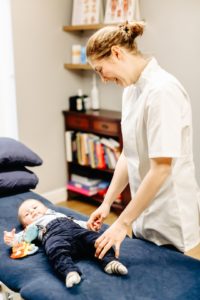
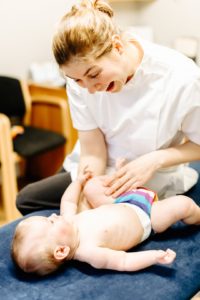
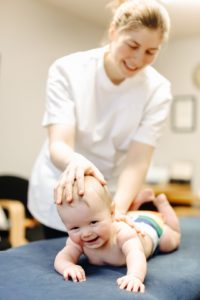
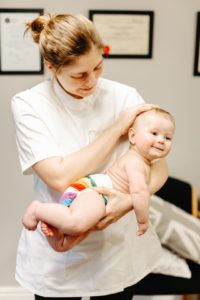
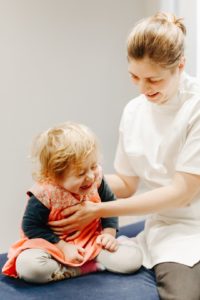
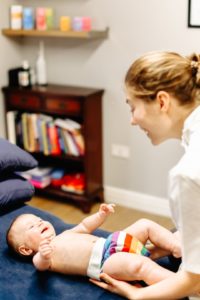
For mother
After giving birth, the mother’s body has to cope both with the changes it made during pregnancy and the effects of delivery. During labour the pelvis will often be pulled out of balance by the passage of the baby. On top of that new mums often feel quite traumatised by the labour experience.
Further on as the baby is growing mums tend to focus all their attention on the baby and they often neglect themselves. The effects of feeding in poor postures, carrying the car seat around and rocking the baby to sleep all cause enormous strain on the back. So it is no surprise that the new mum will experience pains such as low back pain, pelvic pains, sciatica, neck and shoulder pains, general fatigue, or headaches rising from the neck.
During the treatment we aim to help the mum return to normal, physically and emotionally, after giving birth by releasing muscle and joint strains in the body. We use several techniques to achieve this including muscle and soft tissue techniques, joint manipulations and articulations, cranial techniques and visceral techniques.
For baby
As the baby undergoes the delivery and goes from a safe environment to being introduces to a cold big world, this can be quite traumatic for the baby.
In any in uterus position and delivery, the baby may have been squashed, pulled or twisted in different ways and this might leave the baby feeling uncomfortable. Unresolved birth stresses may contribute to many different problems as the child grows.
We recommend that the baby should be checked after birth. Common difficulties that might arise showing the baby is uncomfortable are problems with sleeping, crying, feeding and digestive difficulties. Sometimes a baby with a preference for breastfeeding on one side may have difficulty moving their head freely to both sides. This might be remarked also if the baby prefers looking to one side.
Osteopathic treatment for babies and children is more specialized and uses more gentle techniques. We tend to use cranial osteopathy where we feel the gentle movement of the cranial bones and attempt to resolve any restrictions. Often babies find it very pleasant and fall asleep during the treatment.
If you would like to know more about treatment for mother and baby please don’t hesitate to contact us.
What should I wear?
You will be asked to undress to your underwear if you are comfortable with that. Otherwise we ask you to wear loose fitting clothes.
Can I bring a friend or relative?
You can have somebody present during the whole process. If the patient is under the age of 16 we ask a parent or guardian to be present at all times.
Does it hurt?
Some treatment might cause discomfort during or after treatment. We will explain what to expect during the treatment process. You may feel stiff or sore after treatment but this is a normal and healthy response to the treatment.
Do I need to see my doctor first?
You do not need to see your doctor first if you are paying for your own treatment. Some insurance companies require you to see your doctor first.
How much does treatment cost?
Principal Justine Putman Bsc (Hons) Ost D.O.
Adult initial Osteopathy consultation up to 50 mins: £65
Adult follow up treatments up to 40 mins: £55
Children under 12 initial Osteopathy consultation up to 50 mins: £58
Children under 12 follow up treatments up to 40 mins: £48
Associate Karen Smith B. Ost
Adult Initial Osteopathy consultation up to 70 mins: £58
Adult follow up treatments up to 40 mins: £48
How many treatments will I need?
The number and frequency of treatments you need depends on the condition and the person we are treating. We aim to keep your appointments to a minimum.
We will be able to let you know within a short period of time whether we can treat your complaint or if we need to refer you to someone else.
